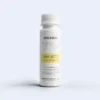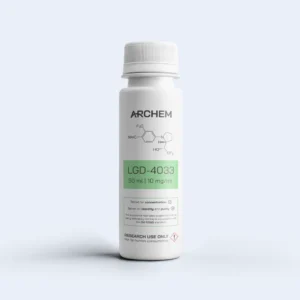Product Overview
RAD-140, commonly referred to as Testolone, is a nonsteroidal, selective androgen receptor modulator (SARM) that offers researchers a finely controlled tool to explore androgenic signaling pathways. This compound is distinguished by its targeted receptor engagement, designed to preferentially bind androgen receptors in skeletal muscle and bone tissue, while sparing other hormone-sensitive sites. Its distinctive mode of action positions RAD-140 as a valuable reference standard in advanced molecular and physiological studies.
Researchers engaged in endocrinology, regenerative medicine, sports physiology, and gerontology have shown keen interest in RAD-140 for its capacity to inform and shape future intervention strategies. Although not intended for clinical therapeutic use, RAD-140’s profile supports critical investigations into the underlying mechanisms that govern muscle hypertrophy, bone homeostasis, and androgen-dependent gene expression.
Our RAD-140 is characterized by high purity and verified identity, ensuring its suitability for rigorous in vitro and in vivo applications. You may find RAD-140 beneficial to elucidate the principles that could guide next-generation treatments for muscle-wasting conditions, osteoporosis, or age-related anabolic decline.
Key Features and Molecular Characteristics
- Selective Androgen Receptor Activity:
Unlike traditional anabolic agents that broadly influence multiple endocrine pathways, RAD-140 is engineered with a selective approach. It binds with elevated affinity to androgen receptors in muscle and bone cells, minimizing interactions with other hormone-sensitive tissues. Such specificity improves the clarity of mechanistic studies, allowing researchers to isolate the receptor-ligand of greatest interest. - Nonsteroidal Structural Design:
RAD-140’s structural framework diverges from steroidal backbones, a feature that simplifies the interpretation of receptor-dependent outcomes. Its nonsteroidal nature may reduce confounding off-target effects often associated with steroid derivatives. This structural clarity ensures more direct insights into receptor function, transcriptional activation, and downstream signaling pathways. - Therapeutic Research Implications:
While no clinical application is established, the properties of RAD-140 have attracted attention in the context of potential therapies. In preclinical models, RAD-140 has been associated with enhanced lean mass retention and improved bone density parameters. These findings encourage further laboratory inquiries into potential modalities for treating muscle atrophy, osteoporosis, or hypogonadism. By studying RAD-140’s action, scientists can build a deeper conceptual framework that may guide future drug development.
Analytical Data and Specifications
- Chemical Formula: C20H16ClN5O2 (commonly referenced in literature)
- CAS Number: 1182367-47-0
- Molecular Class: Selective Androgen Receptor Modulator (SARM)
- Physical Appearance: Off-white to pale solid powder, highly purified and quality-checked
- Purity: ≥98% (HPLC) to ensure reliable and reproducible data acquisition
Each batch of RAD-140 undergoes a comprehensive quality control regimen, including HPLC, mass spectrometry, and NMR characterization. These steps confirm the compound’s identity, purity, and stability. Such rigorous verification allows researchers to rely on consistent, high-quality material for their investigative protocols.
Storage and Handling Guidelines
- Storage Conditions:
RAD-140 should be stored at –20 °C, shielded from direct light and atmospheric moisture. Under these conditions, the compound maintains its integrity for extended periods, preserving accuracy in experimental assays. - Handling Precautions:
Adhere to standard laboratory safety protocols when manipulating RAD-140. Use appropriate personal protective equipment—gloves, a lab coat, and a certified respirator or mask—especially when handling concentrated powders. Although no extensive toxicological profile is fully established, it is prudent to handle all research chemicals with care. Work in a well-ventilated fume hood and consult safety data sheets before initiating experimentation. - Solubility and Preparation:
RAD-140 is typically soluble in DMSO, ethanol, or other organic solvents. Prior to commencing bioassays, users should establish optimal solubility conditions to ensure uniform dispersion and accurate dosage administration. Confirming solubility parameters contributes to reproducible outcomes and clearer interpretation of the experimental data.
Research Applications
- Androgen Receptor Mechanistic Studies:
RAD-140 provides a platform to investigate receptor-ligand binding kinetics, receptor conformational changes, and transcription factor recruitment. By dissecting these processes at the molecular level, researchers can better understand how selective binding leads to distinct cellular outcomes. - Muscle Growth and Maintenance Models:
In studies simulating muscle-wasting diseases, immobilization, or aging, RAD-140 can serve as an experimental variable. Researchers may employ controlled dosages to probe how androgen receptor stimulation influences muscle protein synthesis, atrophy inhibition, and satellite cell activation. These investigations may lay the groundwork for therapies aimed at restoring or preserving muscle mass under pathological conditions. - Bone Density Investigations:
The specificity of RAD-140 for muscle and bone tissues encourages its use in preclinical models of osteoporosis and related disorders. By examining how RAD-140 modulates osteoblastic and osteoclastic activity, researchers can gain insights into targeted strategies to enhance bone mineral density, potentially informing the development of safer anabolic agents for bone health management. - Comparative Studies with Other SARMs uk:
RAD-140 can be an ideal benchmark to compare against other selective androgen receptor modulators, such as Ostarine By contrasting receptor affinity, gene expression profiles, and downstream physiological changes, investigators clarify how subtle variations in molecular structure yield distinct pharmacodynamic outcomes. This comparative approach refines the selection criteria for new compounds with therapeutic potential.
Ethical and Regulatory Considerations
This product is intended strictly for laboratory research and development purposes. Under no circumstances should it be administered to humans or animals outside of ethically supervised preclinical studies. Any experimental use involving in vivo models must comply with institutional, national, and international guidelines. Regulatory authorities, such as doping control agencies, classify RAD-140 as a prohibited substance in sports. Users must be aware of and adhere to all relevant regulations.








